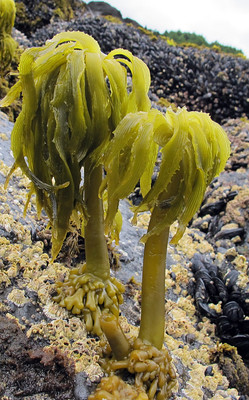Sea palm’s rubbery stalks allow it to bounce right back.
 Watch as a wave crashes over them and you’ll see them bounce back up as the water sheds off. Seaweeds have several substances that make them flexible and rubbery—both helpful in avoiding damage by fast-moving water. Two of those, agar and carrageenan, are widely used to make human foods smooth or gelatinous. From toothpaste to soft-serve ice-cream, you’ve certainly eaten seaweed products!True to their name, sea palms look like one- to two-foot tall palm trees, with a smooth “trunk” topped by a thick tuft of ridged “leaves,” each several to ten inches long, that loosely droop down, reaching a quarter to half the way to the rock. The upright stalk is held in place by a mass of curved and branching finger-like projections that hold fast to rock or mussels. The entire seaweed is olive brown.
Watch as a wave crashes over them and you’ll see them bounce back up as the water sheds off. Seaweeds have several substances that make them flexible and rubbery—both helpful in avoiding damage by fast-moving water. Two of those, agar and carrageenan, are widely used to make human foods smooth or gelatinous. From toothpaste to soft-serve ice-cream, you’ve certainly eaten seaweed products!True to their name, sea palms look like one- to two-foot tall palm trees, with a smooth “trunk” topped by a thick tuft of ridged “leaves,” each several to ten inches long, that loosely droop down, reaching a quarter to half the way to the rock. The upright stalk is held in place by a mass of curved and branching finger-like projections that hold fast to rock or mussels. The entire seaweed is olive brown.
Seaweeds don’t have a circulatory system like land plants; the curved and branching finger-like projections that hold it fast to rock or mussels do only that, hold fast.
While sea palms are built to stand up to the forces associated with the ocean, they are sensitive enough to deserve special protections. No collection of sea palms is allowed from anywhere on Oregon's Ocean Shore State Recreation Area.
Notice where sea palms are growing.
Their tough resilience allows sea palms to thrive where waves crash and currents surge the wildest. They can take the waves, but people cannot: If you find yourself near sea palms, you should move to a safer location.
